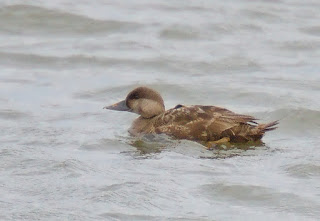The common scoter (Melanitta nigra) is a sea-duck that has seen a drastic decline in recent years in terms of its breeding population in the United Kingdom, thus making it a “red list” species. It is most likely to be seen, during the breeding season, in the far north of Scotland. It winters along the UK coast with concentrations in west and south Wales, the Moray Firth in Scotland and the north Norfolk coast in England.
It is distributed in greater numbers in northern Europe, northern Asia and Alaska, with breeding grounds in the tundra of Iceland, Finland, Russia and elsewhere. Migrant groups can be seen in western Europe, the Baltic and as far south as northwestern Africa.
Appearance and behaviour
At 46-51 centimetres (19 inches) in length, the common scoter is smaller than its cousin the velvet scoter. It is of squat build with a short neck, longish pointed tail and dark green legs. Male common scoters are all black except for some yellow on the upper bill, which has a pronounced knob. Females are brown with pale patches below the eye extending to the upper neck. Juvenile birds also have this pale patch which turns dark in male birds but not in females.
Like the velvet scoter, the common scoter is a strong flyer, often low over the sea in snaking lines, its wings whistling as they beat rapidly. It swims buoyantly with its tail raised. It can be seen stretching its neck, shaking its head and raising its tail vertically, spreading it in a fan.
It rarely comes to land (or even to sand-banks), except to nest, but when it does it walks awkwardly with an upright posture.
The common scoter has a whistling or piping call that is high-pitched and plaintive in the males and hoarse and grating in the females.
Feeding
The diet comprises small crustaceans, molluscs, larvae, worms and aquatic vegetation. Common scoters dive for their food, at depths of up to six metres. Although they dive from the surface, common scoters will escape danger from skuas (etc) by diving from mid-flight.
Breeding
Common scoters reach their breeding grounds in May, choosing a nesting site near water in moorland or tundra. The nest is hidden in long grass, or under a bush or among rocks. It is thinly lined with moss or dry grass.
The clutch is from five to eight eggs, which the female incubates on her own for up to 31 days, abandoned by her partner who takes no further part in family life. Only one brood is raised.
Once hatched, the ducklings are led to the water by their mother who looks after them for six or seven weeks, after which they are left to fend for themselves, gathering into flocks for protection. Common scoter “rafts” can be seen offshore, sometimes with smaller numbers of velvet scoters mixed in with them. This habit makes scoters of both kinds vulnerable to oil spills and may be the main reason why the common scoter is now a red list species.
© John Welford

No comments:
Post a Comment